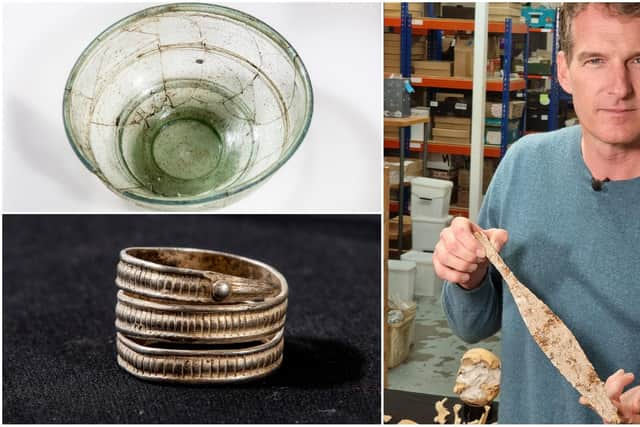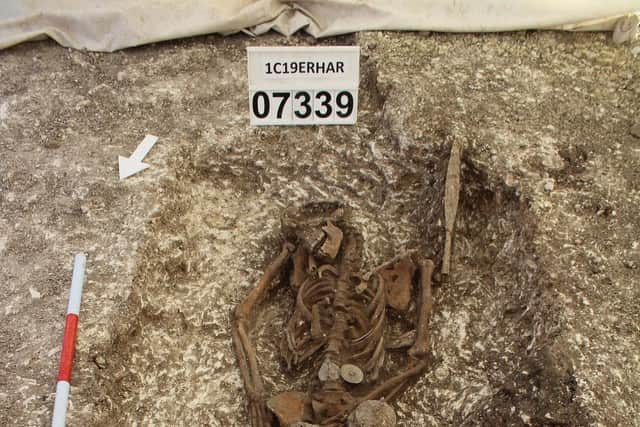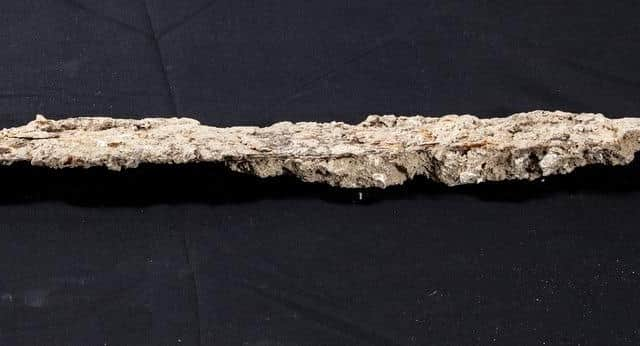Video shows Anglo Saxon swords and shields among 'astonishing' FIFTH CENTURY finds in Wendover
and live on Freeview channel 276
Archaeologists have identified items from the Dark Ages in their exploration of a burial site on the HS2 route.
As well as swords, shields, and spears, 1,500-year-old hygiene kits containing ear wax removers and tweezers have been recovered.
Advertisement
Hide AdAdvertisement
Hide AdThese rare discoveries are featured on Dan Snow’s History Hit podcast which is out now.
Overall, the archaeologists inspected 138 graves, saying that three quarters of them contained high quality grave goods.
This suggests that the resting place was earmarked for wealthy people who died in the fifth and sixth century.


There are gaps in the historical and archaeological record of this time period, meaning these findings can contribute a significant amount to the understanding of how people in Anglo-Saxon Britain lived.
Advertisement
Hide AdAdvertisement
Hide AdThe items found will help experts learn more about what culture and society was like in the Anglo-Saxon age.
Around 30 archeologists were working on the site, from INFRA JV, on behalf of contractor Fusion JV.
Previously their field work has revealed findings from the Neolithic, Bronze Age, Iron Age and Roman times.


As well as the 138 graves, 41 inhumation burials and five cremation burials were discovered, HS2 believes it is one of the largest Anglo-Saxon burial grounds found in the UK.
Advertisement
Hide AdAdvertisement
Hide AdDan Snow said: “Fifteen thousand years ago people in Britain stopped writing things down.
"Traditionally this period has been dismissed as a Dark Age.
"But archaeology has filled the gaps.


"By studying the things our forebears have left in the ground, their glass, jewellery, weapons and even their bodies, we can build a rich picture of a dynamic and vital period of our history.
"This stunning set of discoveries on the HS2 route can tell us more about how our predecessors lived, fought and ultimately died.
Advertisement
Hide AdAdvertisement
Hide Ad"It is one of the best and most revealing post Roman sites in the country and it was thrilling to join the team as they uncovered their wonderful finds.“
A HS2 spokesman said: “Many of burials were found with two brooches on their collarbone, indicating that they would have been holding up garments such as a cloak, or a peplos – a long garment worn by women with shoulder brooches.
"The brooches vary in style – some were disk brooches made with gilt, or coin brooches made of silver.
"A pair of small square-headed brooches were excavated – a miniature form of the great square-headed brooch, such as the famous Chessell Down Brooch on display at the British Museum.
Advertisement
Hide AdAdvertisement
Hide Ad“Some of the items uncovered could have been imported from across Europe, such as amber beads, and various metals and raw materials used to make the artefacts.
"Two glass cone beakers were uncovered intact, which are similar to vessels made in Northern France, although they were also making them in England at the time.
"The beakers, which would have been used for drinking liquids such as wine, may suggest the people there had access to fine beverages from abroad.
"The vessels have decorative trails in the glass and are comparable to the “Kempston” type cone beaker, uncovered in Bedfordshire in 1891, with one currently on display in the British Museum.
Advertisement
Hide AdAdvertisement
Hide Ad“One individual, a female, was discovered with a vast array of goods, the quality of which suggest that she was of high-status amongst the buried population at the site.
"She was buried with a complete ornate glass bowl made of pale green glass, thought to be made around the turn of the fifth century, so could have been an heirloom from the Roman era.
"Other burial items included multiple rings made of copper alloy, a silver ‘zoomorphic’ ring, brooches, discs, iron belt fittings and objects made of ivory.”
Talking about the excavations, Mike Court, lead archaeologist for HS2 Ltd, said: “As we near the end of our archaeology field work on Phase One of HS2, we are just at the beginning of our understanding of how the discoveries will improve our historical knowledge of Britain.
Advertisement
Hide AdAdvertisement
Hide Ad“The archaeological finds made at this site in Wendover will not only be of interest to the local community but are of national importance, providing a valuable insight into life in Anglo-Saxon Britain.”
Overall, 2,000 beads were recovered in the excavation along with 89 brooches, 40 buckles, 51 knives, 15 spearheads and seven shields.
Dr Rachel Wood, lead archaeologist for Fusion JV, added: “This significance of this site for our historical and archaeological understanding of Anglo-Saxon Britain is huge.
"It is not a site I would ever have anticipated finding - to have found one of these burials would have been astonishing, so to have found so many is quite unbelievable.
Advertisement
Hide AdAdvertisement
Hide Ad“The proximity of the date of this cemetery to the end of the Roman period is particularly exciting, especially as it is a period we know comparatively little about. The material objects will tell us so much about the people who lived during this period, as will the people themselves.”
Archaeologists noted how the goods with each burial appeared to be tailored to each individual – suggesting the items would have held some relevance and significance to the deceased and the mourners at the graveside.
A number of grooming items were discovered, such as toiletry sets consisting of ear wax removers and toothpicks, tweezers, combs and even a cosmetic tube that could have contained a substance used as eyeliner or similar.
One unique burial was found with a sharp iron object embedded in the spine of the individual, perhaps giving an insight into the cause of death.
The skeleton, thought to be a male aged between 17-24 at the time of death, was examined by specialist osteologists who believe the weapon was delivered from the front before embedding in the spine.
